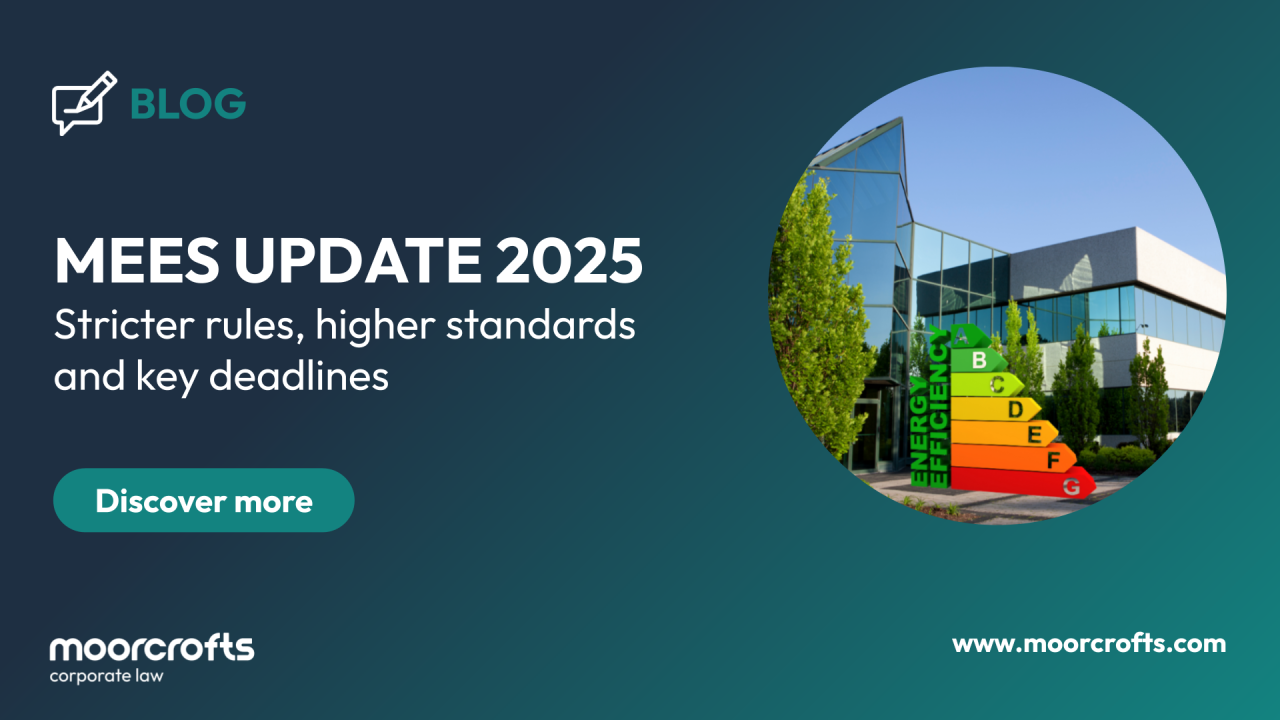MEES Update 2025: Stricter Rules, Higher Standards and Key Deadlines
The Minimum Energy Efficiency Standards (MEES) were introduced on 1 April 2018 to improve the energy performance of commercial buildings, which account for around 20% of the UK’s carbon emissions. Businesses are facing increasing pressure from customers wanting to ensure ESG credentials throughout their supply chain and whilst companies are addressing energy usage and omissions in their own operations, there has been little co-operation to date between landlords and tenants as to how to decarbonise commercial premises and who should bear the cost of this. With the Government’s target of net zero by 2050 and 60% of today’s buildings expected to remain in use by then, improving energy efficiency is crucial.
Key Rules
- Since 1 April 2023, it has been illegal for a landlord to let (or continue letting) commercial premises with an Energy Performance Certificate (EPC) rating of F or G, unless the property is excluded from the requirement to have an EPC or an exemption is registered.
- Failure to comply with MEES may result in fines of up to £150,000 and reputational damage.
When is an EPC Required?
EPCs are valid for 10 years and are mandatory for:
- All commercial lettings (new leases (including renewals) and existing lettings) of more than six months (subject to some qualifications) and less than 99 years.
- Commercial property sales.
- Tenant assignments and sublets, if no valid EPC exists.
- The carrying out of certain works which impact the environmental performance of a commercial building.
EPC’s are not required for
- Places of worship, temporary buildings, some low-energy industrial/agricultural buildings, and in some circumstances buildings which are due to be demolished.
- Listed buildings, if the works required to improve the rating are not permitted due to the listing.
- “Non-buildings”, such as open car parks or kiosks under 50m².
But beware, if an EPC is voluntarily obtained for a property that would otherwise be exempt, compliance with the MEES will be triggered.
What are the Exemptions?
Even if a property is caught by the MEES a landlord may still be able to let it out if one of the exemptions apply.
| Exemption | Details |
| Seven-Year Payback | If improvement costs do not pay for themselves in energy savings over seven years. |
| All Improvements Made | If all possible upgrades have been completed but the EPC rating remains below an E. |
| Wall Insulation | If, where the relevant improvements relate to wall insulation, an independent surveyor confirms that the works are not technically feasible or would cause damage to the property. |
| Consent Issues | If the Landlord fails to obtain third-party consent (e.g. tenant, freeholder, planning authority) which is needed for the improvement works or such consent is given subject to conditions which the landlord cannot reasonably comply with. |
| Devaluation | If an independent surveyor confirms that required works reduce the property’s value by 5% or more. |
| Temporary Exemptions | A temporary six-month exemption to allow time for compliance or registration of a full exemption, where a lease is renewed under the LTA 1954; for newly acquired properties subject to leases or where the lease has been granted pursuant to a contractual obligation. |
The MEES do not mandate specific works but prohibit leasing substandard properties without an exemption. Exemptions last five years, must be registered via the PRS Exemptions Register, are personal and must be renewed even if conditions remain unchanged.
Penalties for Non-Compliance
Financial Consequences:
- Breaches of less than three months → Fine of £5,000 or 10% of the rateable value (whichever is higher).
- Breaches longer than three months → Fine of £10,000 or 20% of the rateable value (capped at £150,000).
The landlord’s details will also be put on a “name and shame” register.
Beyond fines, MEES non-compliance can have serious financial and legal consequences for landlords. Properties that fail to meet the required EPC standards may become unlettable, preventing landlords from generating rental income until necessary upgrades are completed. At lease expiry, tenants may resist dilapidation claims, arguing that the property is already substandard and that if the landlord is required to carry out fundamental energy efficiency improvements, the true value of their dilapidations liability should be significantly reduced. Additionally, non-compliant buildings may face challenges during rent reviews, as substandard premises may struggle to justify market rents, leading to lower rental income.
From April 2025, enforcement is expected to become more proactive and the minimum acceptable rating is also due to increase from E, to C and then to B.
- By 1 April 2025 – All rented properties must have a valid (i.e. in date) EPC.
- By 1 April 2027 – Properties must achieve a rating of at least C (or register a valid exemption).
- By 1 April 2028 – EPCs must be reviewed for further necessary upgrades.
- By 1 April 2030 – All rented properties must achieve a rating of at least B (or register an exemption).
Key Challenges & Considerations for MEES Compliance
Landlords face significant challenges in ensuring compliance with the MEES regulations. One major concern is the risk to property valuation, as buildings that fail to meet MEES requirements may be devalued by investors due to the high costs associated with energy efficiency upgrades. Landlords may also need to consider tighter restrictions on alterations in order to maintain EPC compliance, by controlling alterations that could negatively impact energy efficiency. Access rights present another hurdle, as upgrades often require tenant cooperation, and without clear lease provisions, landlords may struggle to carry out the necessary work.
To mitigate these risks, landlords should look to carefully structure leases to ensure they retain access rights for upgrades and clearly outline the division of costs. Strategic investment planning is also crucial, as factoring in the potential impact on valuation and upgrade expenses can help safeguard long-term property values.
Although compliance with the MEES rests with landlords at the moment, tenants will need to consider the regulations when seeking to sublet or assign a lease. Additionally, tenants planning alterations or refurbishments may find that their lease prohibits any modifications that could negatively impact the property’s EPC rating. Older leases may have limited provisions in relation to MEES but the impact of the MEES is becoming more relevant in current lease negotiations, with landlords attempting to shift the financial burden of compliance onto tenants. Where the lease is of part of a building the landlord may be able to recover the costs of upgrading the environmental performance of the common parts through the service charge.
To navigate these challenges, tenants should conduct thorough due diligence before signing a lease, ensuring the property meets the minimum compliance requirements and that the lease terms do not unfairly impose MEES-related costs on them. This will be a question of commercial negotiation and whilst from a tenant perspective a carve out of all MEES costs is desirable, it may be reasonable to agree a shared cost provision if planned improvements will reduce underlying energy costs that the tenant is responsible for. Any planned modifications should also be carefully reviewed to prevent conflict with landlords over energy efficiency concerns.
Final Thoughts: Get Ahead of MEES Compliance
With stricter EPC targets approaching, a minimum rating of C by 2027 and B by 2030, proactive planning is essential. Landlords should review existing EPCs, identify non-compliant properties and plan upgrades early, particularly for vacant buildings where disruption is minimal. Tightening lease provisions to prevent tenant alterations that could lower EPC ratings is also important.
Meanwhile, tenants should review EPC ratings before leasing commercial space to assess long-term viability, carefully consider the impact of any fit out and seek to negotiate lease terms to avoid unexpected upgrade costs.
A collaborative approach between landlords and tenants will be fundamental however to creating sustainable workplaces whilst balancing financial responsibilities. By planning ahead, reviewing lease terms, and future-proofing properties, both parties can stay compliant and competitive in an increasingly eco-conscious market.



